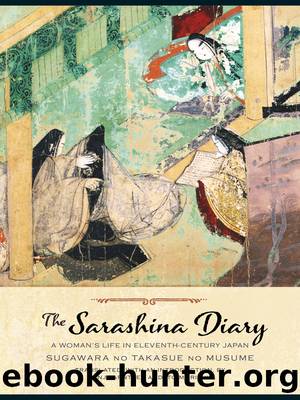The Sarashina Diary: A Woman's Life in Eleventh-Century Japan by Takasue no Musume Sugawara no Sonja Arntzen Moriyuki Ito

Author:Takasue no Musume Sugawara no, Sonja Arntzen, Moriyuki Ito
Language: eng
Format: epub
Tags: -
Publisher: Columbia University Press
Published: 2014-06-05T16:00:00+00:00
FIGURE 6 An Edo-period print of KÅryÅ« Temple in Uzumasa.
hanami ni yuku to We were on our way to see flowers;
kimi wo miru kana how wonderful to see you instead.
My companion said, âIn a case like this, it is impolite not to respond.â So I had someone deliver this reply:
chigusa naru With hearts as always
kokoro narahi ni pulled by myriad attractions,
aki no no no in the autumn moors.195
With just that, we passed by. On the seven days of the retreat, I was finally able to separate my mind from frivolous things; all I could think of was the road to the east. My prayer was, âPlease let me see him safe again.â I felt as though the Buddha might have listened with compassion.
Winter came. On a night after a day when the rain had been falling all day long, a wind capable of returning all the clouds to their home blew fiercely, the sky cleared, and the moon was strikingly bright. The rushes that reached up close to the eaves had been blown about terribly by the wind and lay broken in disarray. Moved by the touching sight:
aki wo ika ni In winterâs depths,
omohi idzuramu how much must they recall
fuyu fukami the fine days of autumn,
arashi ni madofu withered leaves of rushes
wogi no kareha ha blown in disarray by the storm.
Someone came from the East Country bearing a letter:
âWhile I was touring the shrines of this province performing the offical ritual prayers,196 in an area where there were lovely flowing streams and wide, wide plains, there was one place with a forest grove. âWhat a charming place,â I thought to myself, and right away I was reminded of you and sorry that I could not show it to you. âWhat is this place called?â I asked, and someone replied, âSir, they say it is called âLonging for Oneâs Child Forest.ââ197 Since I could not help comparing it to myself and feeling terribly sad, I dismounted and gazed at it deep in thought for a couple of hours or more.
todomeokite Having left
waga goto mono ya a child behind, how like me,
omohikemu it must have felt.
miru ni kanashiki Looking at it, I feel sad,
ko shinobi no mori âLonging for Oneâs Child Forestâ
That is just how I felt.â
One must imagine my feelings when reading this letter. I replied with this:
ko shinobi wo Just hearing,
kiku ni tsukete mo âLonging for Oneâs Child,â I regret
todomeokishi being left behind;
chichibu no yama no âFather Mountainâ198 all alone
tsuraki adzumadji on the roads of the East Country.
In this way, as I drifted along in life, I wondered why I had not gone on pilgrimages. Of course, my mother was very old-fashioned: âA trip to Hatsuse (figure 7)?199 How frightening the thought! What would I do if you were abducted on the Nara Slopes?200 If we went to Ishiyama,201 it would be terrifying to cross Sekiyama.202 And Kurama (figure 8);203 the thought of taking you to that mountain also scares me. Anyway, until your father gets back, it is out of the question.
Download
This site does not store any files on its server. We only index and link to content provided by other sites. Please contact the content providers to delete copyright contents if any and email us, we'll remove relevant links or contents immediately.
Blood and Oil by Bradley Hope(1251)
Daniel Holmes: A Memoir From Malta's Prison: From a cage, on a rock, in a puddle... by Daniel Holmes(1118)
Ambition and Desire: The Dangerous Life of Josephine Bonaparte by Kate Williams(1088)
Wandering in Strange Lands by Morgan Jerkins(1019)
It Was All a Lie by Stuart Stevens;(943)
What Really Happened: The Death of Hitler by Robert J. Hutchinson(872)
London in the Twentieth Century by Jerry White(848)
Time of the Magicians by Wolfram Eilenberger(844)
Twilight of the Gods by Ian W. Toll(814)
The First Conspiracy by Brad Meltzer & Josh Mensch(813)
The Japanese by Christopher Harding(804)
A Woman by Sibilla Aleramo(797)
Lenin: A Biography by Robert Service(780)
The Devil You Know by Charles M. Blow(780)
Reading for Life by Philip Davis(775)
Cleopatra by Alberto Angela(769)
Twelve Caesars by Mary Beard(769)
1965--The Most Revolutionary Year in Music by Andrew Grant Jackson(715)
The Life of William Faulkner by Carl Rollyson(714)
